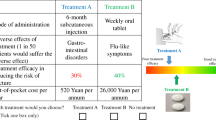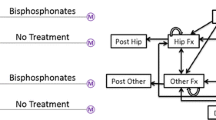Abstract
Background: Osteoporotic fractures have a serious economic impact on society and on the quality of life of patients. Differences in opinions on the desirability of preventive treatment initiation may hamper the process and outcome of shared decision making between physician and patient.
Objective: To evaluate and compare preferences of GPs and patients for preventive osteoporosis drug treatment.
Methods: Discrete-choice experiment (DCE) involving 34 general practices in the area of Rotterdam, the Netherlands. Participants included 40 GPs and 120 women aged ≥60 years who participated in a study on osteoporosis case finding. We included any woman aged >60 years, with an over-representation of women with a high fracture risk (n = 60).
Outcomes: (i) The relative weights that GPs and patients place on five treatment attributes of preventive osteoporosis drug treatment: effectiveness, nausea as an adverse effect, total treatment duration, route of drug administration and out-of-pocket costs; and (ii) the determinants of any differences in preferences between GPs and patients.
Results: The response rate was 40/59 (68%) for GPs and 120/181 (66%) for patients. All treatment attributes proved to be important for preferences of GPs and patients. GPs had a significantly less favourable attitude towards preventive osteoporosis drug treatment than patients; they placed significantly higher values on effectiveness of preventive drug treatment and short total preventive treatment duration than patients.
Conclusions: GPs and patients showed different preferences towards preventive osteoporosis drug treatment. Addressing each of these differences may have a positive effect on the process and outcomes of shared decision making regarding preventive treatment initiation.





Similar content being viewed by others
References
Montgomery AA, Fahey T. How do patients’ treatment preferences compare with those of clinicians? Qual Health Care 2001 Sep; 10 Suppl. 1: i39–43
Consensus development conference: prophylaxis and treatment of osteoporosis. Am J Med 1991 Jan; 90 (1): 107–10
Riggs BL, Melton 3rd LJ. The worldwide problem of osteoporosis: insights afforded by epidemiology. Bone 1995 Nov; 17 (5 Suppl.): 505S-11S
Guideline on osteoporosis. Utrecht: The Dutch Institute for Healthcare Improvement (CBO), 2002 [in Dutch; online]. Available from URL: http://www.cbo.nl/product/richtlijnen/folder20021023121843/osteoporose.pdf? [Accessed 2009 Feb 17]
Atik OS, Gunal I, Korkusuz F. Burden of osteoporosis. Clin Orthop Relat Res 2006 Feb; 443: 19–24
Silverman SL. Quality-of-life issues in osteoporosis. Curr Rheumatol Rep 2005 Mar; 7 (1): 39–45
Black DM, Cummings SR, Karpf DB, et al. Randomised trial of effect of alendronate on risk of fracture in women with existing vertebral fractures. Fracture Intervention Trial Research Group. Lancet 1996 Dec 7; 348 (9041): 1535–41
Ensrud KE, Black DM, Palermo L, et al. Treatment with alendronate prevents fractures in women at highest risk: results from the Fracture Intervention Trial. Arch Intern Med 1997 Dec 8–22; 157 (22): 2617–24
Harris ST, Watts NB, Genant HK, et al. Effects of risedronate treatment on vertebral and nonvertebral fractures in women with postmenopausal osteoporosis: a randomized controlled trial. Vertebral Efficacy With Risedronate Therapy (VERT) Study Group. JAMA 1999 Oct 13; 282 (14): 1344–52
Pols HA, Felsenberg D, Hanley DA, et al. Multinational, placebo-controlled, randomized trial of the effects of alendronate on bone density and fracture risk in postmenopausal women with low bone mass: results of the FOSIT study. Fosamax International Trial Study Group. Osteoporos Int 1999; 9 (5): 461–8
Gyrd-Hansen D, Sogaard J. Analysing public preferences for cancer screening programmes. Health Econ 2001 Oct; 10 (7): 617–34
Ryan M, Farrar S. Using conjoint analysis to elicit preferences for health care. BMJ 2000 Jun 3; 320 (7248): 1530–3
Sculpher M, Bryan S, Fry P, et al. Patients’ preferences for the management of non-metastatic prostate cancer: discrete choice experiment. BMJ 2004 Feb 14; 328 (7436): 382
Watson V, Ryan M, Brown CT, et al. Eliciting preferences for drug treatment of lower urinary tract symptoms associated with benign prostatic hyperplasia. J Urol 2004 Dec; 172 (6 Pt 1): 2321–5
Bishop AJ, Marteau TM, Armstrong D, et al. Women and health care professionals’ preferences for Down’s Syndrome screening tests: a conjoint analysis study. BJOG 2004 Aug; 111 (8): 775–9
Mantovani LG, Monzini MS, Mannucci PM, et al. Differences between patients’, physicians’ and pharmacists’ preferences for treatment products in haemophilia: a discrete choice experiment. Haemophilia 2005 Nov; 11 (6): 589–97
Lee A, Gin T, Lau AS, et al. A comparison of patients’ and health care professionals’ preferences for symptoms during immediate postoperative recovery and the management of postoperative nausea and vomiting. Anesth Analg 2005 Jan; 100 (1): 87–93
Lewis SM, Cullinane FM, Carlin JB, et al. Women’s and health professionals’ preferences for prenatal testing for Down syndrome in Australia. Aust N Z J Obstet Gynaecol 2006 Jun; 46 (3): 205–11
Kanis JA, Delmas P, Burckhardt P, et al. Guidelines for diagnosis and management of osteoporosis: the European Foundation for Osteoporosis and Bone Disease. Osteoporos Int 1997; 7(4): 390–406
de Bekker-Grob EW, Essink-Bot ML, Meerding WJ, et al. Patients’ preferences for osteoporosis drug treatment: a discrete choice experiment. Osteoporos Int 2008; 19(7): 1029–37
Farrar S, Ryan M, Ross D, et al. Using discrete choice modelling in priority setting: an application to clinical service developments. Soc Sci Med 2000 Jan; 50 (1): 63–75
Ryan M, Scott DA, Reeves C, et al. Eliciting public preferences for healthcare: a systematic review of techniques. Health Technol Assess 2001; 5(5): 1–186
Hahn GJ, Shapiro SS. A catalog and computer program for the design and analysis of orthogonal symmetric and asymmetric fractional factorial experiments [report no.: 66-C 165]. Schenectady (NY): General Electric Research and Development Center, 1966
Louviere JJ, Hensher DA, Swait JD. Stated choice methods: analysis and application. Cambridge: Cambridge University Press, 2000
Sloane NJA. A library of orthogonal arrays [online]. Available from URL: http://www.researchattcom/~njas/oadir/ [Accessed 2009 Feb 17]
Slevin ML, Stubbs L, Plant HJ, et al. Attitudes to chemotherapy: comparing views of patients with cancer with those of doctors, nurses, and general public. BMJ 1990 Jun 2; 300 (6737): 1458–60
Macfarlane J, Holmes W, Macfarlane R, et al. Influence of patients’ expectations on antibiotic management of acute lower respiratory tract illness in general practice: questionnaire study. BMJ 1997 Nov 8; 315 (7117): 1211–4
von Haefen RH, Massey DM, Adamowicz W. Serial non-participation in repeated discrete choice models. Am J Agric Econ 2005; 87 (4): 1061–76
Ryan M, Gerard K. Using discrete choice experiments to value health care programmes: current practice and future research reflections. Appl Health Econ Health Policy 2003; 2(1): 55–64
Street D, Burgess L. Discrete choice experiments [computer software]. Sydney: University of Technology, 2007 [online]. Available from URL: http://maths.science.uts.edu.au/maths/wiki/SPExpts [Accessed 2009 Mar 05]
Acknowledgements
The authors thank Huibert A.P. Pols, PhD (Department of Internal Medicine, Erasmus MC — University Medical Centre Rotterdam, Rotterdam, the Netherlands), for his helpful advice in designing the discrete-choice experiment and for his comments on this paper. The Netherlands Organization for Health Research and Development (ZonMw) funded this research (grant number: 945-14-010 HTA). The authors declare the independence of researchers from funders. The authors have no conflicts of interest that are directly relevant to the content of this study.
Author information
Authors and Affiliations
Corresponding author
Rights and permissions
About this article
Cite this article
de Bekker-Grob, E.W., Essink-Bot, ML., Meerding, W.J. et al. Preferences of GPs and Patients for Preventive Osteoporosis Drug Treatment. Pharmacoeconomics 27, 211–219 (2009). https://doi.org/10.2165/00019053-200927030-00004
Published:
Issue Date:
DOI: https://doi.org/10.2165/00019053-200927030-00004




